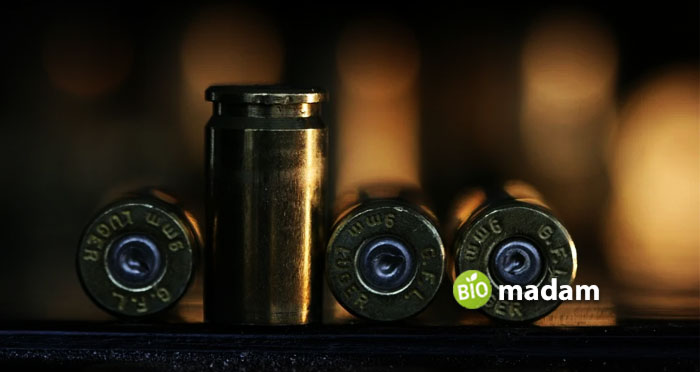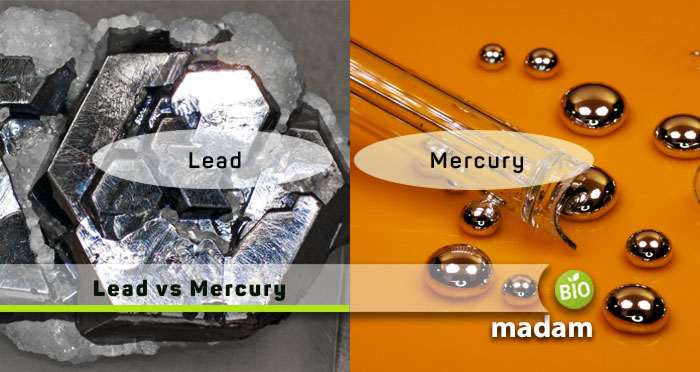Recently updated on October 5th, 2023 at 06:07 am
Lead and mercury are both metals found everywhere around us. They are present in the Earth’s crust and have industrial uses. However, they both are classified as toxic elements for health, and exposure to any of these metals should be avoided. Besides being poisonous and having similar colors, they are different in composition, function, and places where they can be found.
Here’s everything you need to know about Lead and Mercury.
Comparison Table
| Factor | Lead | Mercury |
| Symbol | Pb | Hg |
| State | Solid | Liquid |
| Color | Slate grey | Silver |
| Periodic group | 14 | 12 |
| Family | Carbon | Zinc |
| Atomic number | 82 | 80 |
| Atomic mass | 207.2 | 200.59 |
| Sources | Paints, batteries, lead pencils | Food, and industrial contaminants |
| Poisoning | Cognitive defects, renal disease | Eyes, skin, lungs, kidney |
What is Lead?
Lead is a soft metal in grayish or silvery-white color and is denoted by Pb. It belongs to group 14 (IVa) in the periodic table. It is a ductile, malleable, and dense metal with poor electricity conduction, unlike silver which is a good electric conductor.
Besides being a part of the Earth’s crust, lead is found all around us in the soil, air, and water. It is also present in industries and homes in ceramics, paint, pipes, batteries, etc. People usually experience the harmful effects of lead on continuous exposure to paints or gasoline. You may be surprised to know that cosmetics also have lead, and you might be in taking the lead unintentionally every day.
Properties of Lead
- It is a solid-phase metal.
- It occurs in a Slate gray color.
- The atomic symbol for Lead is Pb.
- It belongs to the carbon family and group 14 of the periodic table.
- The atomic number of lead is 82, and the atomic mass is 207.2.
- The melting point of lead is 327.46°C, whereas the metal boils at 1749°C.
Uses of Lead
Lead is a soft yet strong metal and is typically not destroyed by corrosive liquids and is thus used to store them, especially in industries. It is used in lead glazes when molding pottery in the past. Lead also acts as an anti-knocking ingredient for petrol. Many of these practices have been banned, yet lead is still a part of our daily lives in other ways. Some common uses of lead include weights for lifting, pigments, batteries, ammunition, stained glass windows, and utilization in architecture.
Lead Poisoning
Lead and related compounds are toxic when they enter the body and accumulate over a long time, known as cumulative poisoning. It causes renal disease in adults and results in cognitive defects in children. You may detect lead poisoning through symptoms that include dizziness, nausea, constipation, diarrhea, weakness, and headache. You can prevent further damage by getting rid of the source causing lead poisoning.

What is Mercury?
Mercury is a silver-colored liquid metal, also known as Quicksilver. It is the only metal liquid at room temperature and, thus, called liquid metal commonly. Mercury was first identified in Egypt in 1500 BC and represented by Hg in the periodic table.
Properties of Mercury
- Mercury is in the only metal liquid form at room temperature.
- It is silver in color.
- The atomic symbol for Mercury is Hg.
- Mercury’s atomic number is 80, and its atomic mass is 200.59.
- It melts at -38.83°C and boils at 356.73°C.
Uses of Mercury
Like lead, the use of mercury is also limited or banned because of its toxicity. It had been used in the manufacturing of chlorine and sodium hydroxide, fluorescent lights, and batteries. Vermilion (Mercuric sulfide) color was widely used as a bright red high-grade pigment, but its use is limited due to its toxicity.
While the use of mercury in thermometers is avoided now and they are replaced with digital thermometers, some regions still use mercury thermometers. Now it is used in rectifiers, electrical switches, and as a catalyst (to speed up reactions) in the chemical industry.
Mercury Poisoning
Mercury is a toxic metal and among the top ten chemicals for major public health concerns, according to WHO. It does not only affect adults but causes issues in children and fetuses. Toxic levels of mercury affect the skin, kidneys, lungs, and eyes. Mercury is found in two forms, organic and inorganic. Organic mercury is present in some foods, whereas you may be exposed to inorganic mercury at your workplace. Usually, foods that contain mercury are shellfish and fish.

Differences Between Lead and Mercury
Symbol
Lead
The atomic symbol for lead is Pb.
Mercury
The atomic symbol for Mercury is Hg.
State
Lead
Lead is a malleable and ductile solid metal.
Mercury
While mercury is the only metal liquid at room temperature.
Color
Lead
The lead comes in a greyish color.
Mercury
However, mercury is a silverfish color, not very different to lead.
Periodic Group
Lead
Lead belongs to group no 14 in the periodic table.
Mercury
Whereas mercury falls in group no 12 in the periodic table.
Group Name
Lead
The group name for lead is the carbon family.
Mercury
On the other hand, mercury belongs to the zinc family.
Atomic Number and Atomic Mass
Lead
The atomic number for lead is 82; alternatively, the atomic mass is 207.2
Mercury
Mercury’s atomic number is 80, and its atomic mass is 200.59.
Toxicity
Lead
Lead toxicity usually occurs by inhalation through paints and batteries and can cause cognitive issues in children besides renal disease in adults.
Mercury
Contradicting, mercury toxicity is caused by intaking organic or inorganic mercury and may result in skin, eyes, lung, and kidney damage.
FAQs
How does lead affect pregnant women?
Lead is toxic to pregnant women and puts them at risk of a miscarriage. They can also result in a decreased or prolonged gestational period, affect the child’s brain and kidneys functioning, or cause behavioral issues.
Can you cure lead poisoning?
Sadly there is no cure for lead poisoning, and you can only save yourself by avoiding further contact with lead.
Is there a safe level of lead in the blood of children?
Any amount of lead in blood is not considered safe. Your blood and even plasma should not contain any lead, as a continuous accumulation of lead can lead to serious health issues. To save children from lead poisoning, it is important to remove all forms of lead from the house.
Can you hold mercury?
Students often ask if they can hold mercury. The answer is no. Mercury is much more viscous than water, yet you cannot hold it as it tends to slip from your hands when you hold it.
Can you absorb mercury?
Though mercury is a liquid, it is not absorbable like water or alcohol. Due to its negative surface tension coefficient, mercury is not a wet metal.
Which medical instruments contain mercury?
The usage of mercury is banned and reduced in many parts worldwide; it is still used in numerous medical and scientific instruments like hydrometers, hygrometers, thermometers, barometers, etc.
Is metal the only liquid element?
While mercury is the only liquid metal at room temperature, there are a few other elements in different liquid forms at varying temperatures. Gallium, Francium, Rubidium, and Cesium are liquid metals, but not at room temperature. Bromine is a halogen and liquid at room temperature.
The Bottom Line
Mercury and lead are both found in the Earth’s core and present in numerous forms around us. While lead is abundantly present in batteries and paints, mercury is commonly ingested through mercury-containing foods and industrial usage. Mercury or lead poisoning can cause numerous health issues, including harm to the skin, eyes, lungs, and kidneys. Lead also causes harm to the fetus and young children. You can prevent lead and mercury poisoning by removing sources of ingestion.

Hello, I would like to introduce myself to you! I am Chelsea Rogers, an experienced blog writer for science articles, holding an MPhil degree. My enthusiasm to grab the best knowledge, let it relate to botany, zoology, or any other science branch. Read my articles & let me wait for your words s in the comment section.

